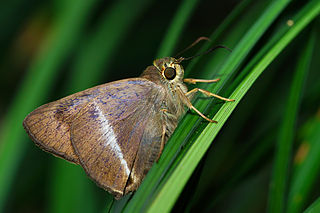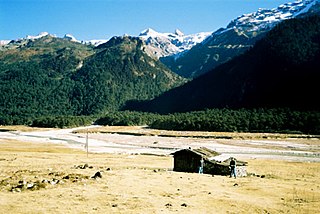
The Lepcha are among the indigenous peoples of the Indian state of Sikkim and Nepal, and number around 80,000. Many Lepcha are also found in western and southwestern Bhutan, Tibet, Darjeeling, the Province No. 1 of eastern Nepal, and in the hills of West Bengal. The Lepcha people are composed of four main distinct communities: the Renjóngmú of Sikkim; the Dámsángmú of Kalimpong, Kurseong, and Mirik; the ʔilámmú of Ilam District, Nepal; and the Promú of Samtse and Chukha in southwestern Bhutan.

Bibasis gomata, commonly known as the pale green awlet, is a butterfly belonging to the family Hesperiidae. It is found in Northeast India, the Western Ghats and parts of Southeast Asia. The butterfly was reassigned to genus Burara by Vane-Wright and de Jong (2003) and is considered by them to be Burara gomata.

Hasora taminatus, the white banded awl, is a butterfly belonging to the family Hesperiidae, which is found in Asia.

Borbo bevani, the Beavan's swift, is a butterfly belonging to the family Hesperiidae. It is named after Captain Robert Cecil Beavan. It is found throughout India.

Iambrix salsala, the chestnut bob, is a butterfly belonging to the family Hesperiidae, that is found in parts of South Asia and Southeast Asia.

Potanthus confucius, the Chinese dart or Confucian dart, is a butterfly belonging to the family Hesperiidae. They are found from Sri Lanka, India to China and Japan and down to Sumatra and Java in Indonesia. Some museum specimens have also been reported to be from Palawan in the Philippines, but due to the absence of the species in Borneo, it is possible that these were mislabeled or misidentified.

Spialia galba, the Indian grizzled skipper, is a hesperiid butterfly which is found in South Asia and parts of Southeast Asia.

Capila zennara, the pale striped dawnfly, is a species of hesperid butterfly found in tropical Asia.

The white-tailed flycatcher is a species of bird in the family Muscicapidae. It is the only member of the monotypic genus Leucoptilon. Prior to 2022, it was classified in the genus Cyornis, but was reclassified into Leucoptilon by the International Ornithological Congress based on a 2021 phylogenetic study.

Capila lidderdali, the Lidderdale's dawnfly, is a species of hesperid butterfly found in India and Southeast Asia.

Zographetus is an Indomalayan genus of grass skippers in the family Hesperiidae.
Hee Gyathang Monastery is a Buddhist monastery situated in Upper Dzongu, North Sikkim in northeastern India. It was built by hermit Abi Putso Rangdrol in 1914.

Mangan subdivision is one of the two sub-districts of North Sikkim district, in the state of Sikkim, India. Mangan is the headquarters. It contains 46 census-designated villages:

The Erionotini are a tribe in the Hesperiinae subfamily of skipper butterflies.

Zographetus ogygia, the purple spotted flitter, is a butterfly belonging to the family Hesperiidae.

Halpe zema, the zema banded ace, is a species of skipper, a butterfly belonging to the family Hesperiidae. It is native to Nepal, India, and Myanmar.

The Kanaka Bridge, is an under construction 2 lane bridge over the Kanaka river at Dzongu village in the Mangan subdivision of Sikkim state in India.















